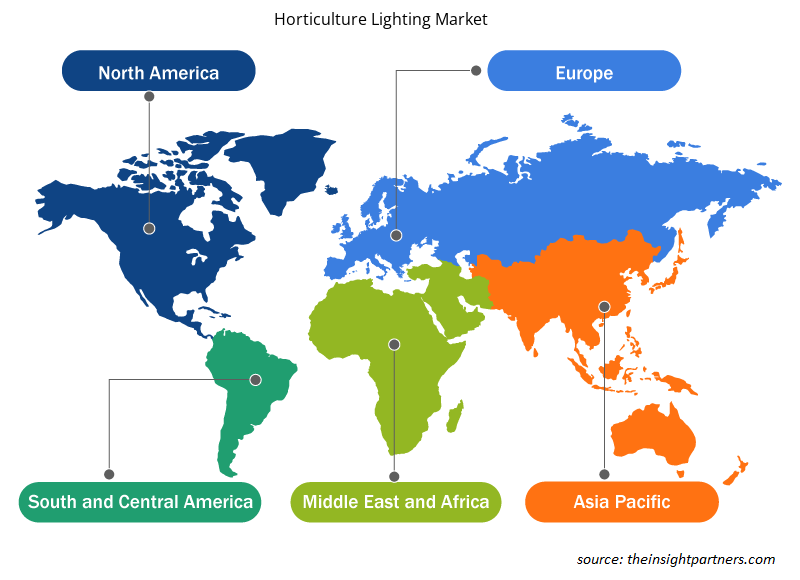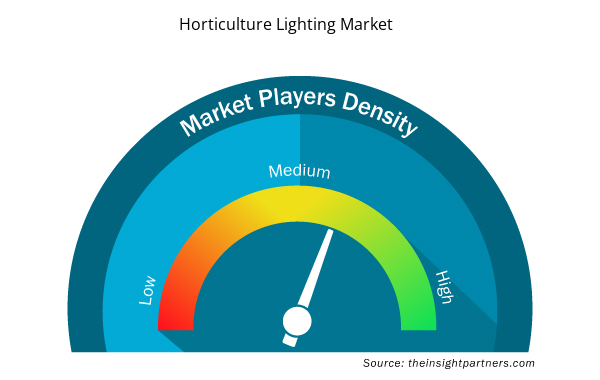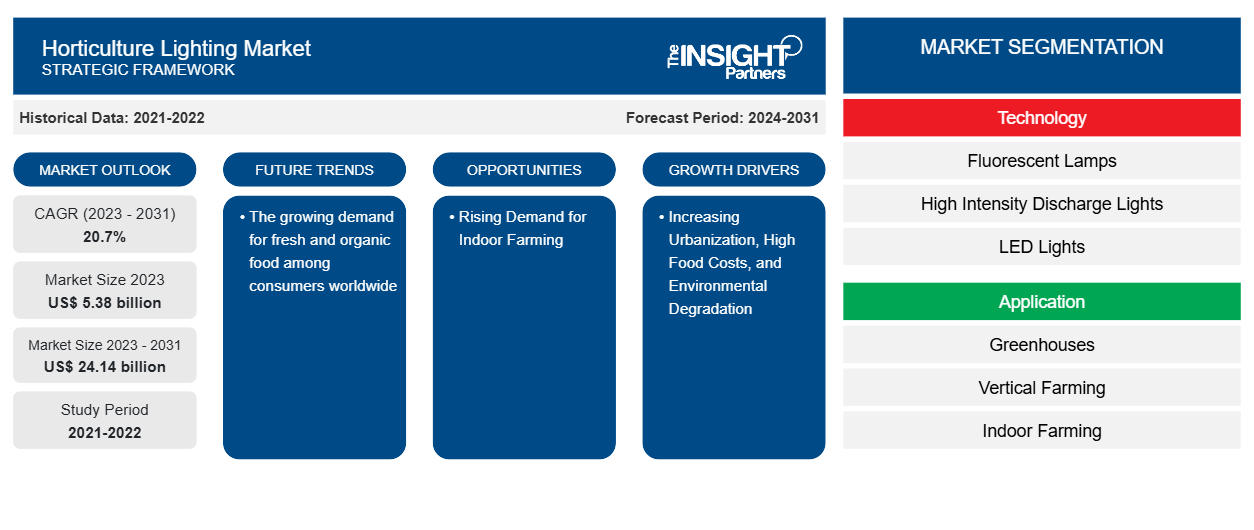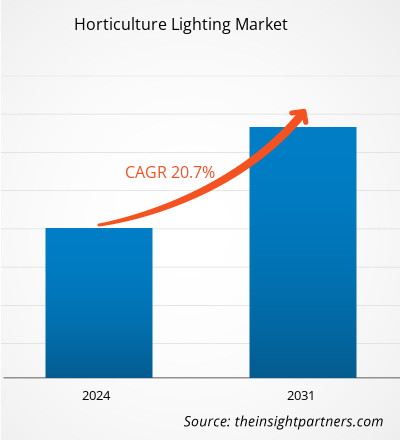من المتوقع أن يصل حجم سوق الإضاءة البستانية إلى 24.14 مليار دولار أمريكي بحلول عام 2031 من 5.38 مليار دولار أمريكي في عام 2023. ومن المتوقع أن يسجل السوق معدل نمو سنوي مركب بنسبة 20.7٪ في الفترة 2023-2031. ومن المرجح أن يظل الطلب المتزايد على الأغذية الطازجة والعضوية بين المستهلكين في جميع أنحاء العالم اتجاهًا رئيسيًا في سوق الإضاءة البستانية.
تحليل سوق الإضاءة البستانية
ينمو سوق إضاءة البستنة بوتيرة سريعة بسبب التوسع الحضري المتزايد، وارتفاع تكاليف الغذاء، والتدهور البيئي، والاستثمار المتزايد في تقنيات البستنة الحديثة، والطلب على حلول الإضاءة المخصصة. يتوسع السوق بشكل مطرد، مدفوعًا بالطلب المتزايد على أجهزة الزراعة الموفرة للطاقة والمبادرات الحكومية لدعم الزراعة الداخلية . علاوة على ذلك، فإن الطلب المتزايد على الزراعة الداخلية وصناعة البستنة المنزلية المتوسعة توفر فرصًا مربحة لنمو السوق.
نظرة عامة على سوق الإضاءة البستانية
إن الإضاءة البستانية هي استخدام مصادر الضوء الاصطناعي لمساعدة النباتات على النمو في ظروف خاضعة للرقابة مثل البيوت الزجاجية والمزارع الداخلية وغرف النمو. تلعب هذه الأضواء دورًا مهمًا في توفير طيف الضوء ومدته وكثافته لمحاكاة أو زيادة أشعة الشمس الطبيعية، وبالتالي تحسين عملية التمثيل الضوئي للنباتات والنمو العام.
إن الإضاءة البستانية هي تقنية مهمة لزيادة المحاصيل الزراعية وإطالة مواسم النمو والحفاظ على جودة النباتات بشكل ثابت. يمكن للشركات إنشاء ظروف مثالية للمحاصيل المتنوعة من خلال الاستفادة من تقنيات الإضاءة المبتكرة، مثل أنظمة LED التي توفر التحكم الدقيق في إعدادات الإضاءة، بغض النظر عن الطقس الخارجي أو القيود الجغرافية. علاوة على ذلك، فإن طبيعة أنظمة الإضاءة البستانية الحالية القائمة على البيانات تمكن المؤسسات من مراقبة وتعديل ظروف الإضاءة في الوقت الفعلي، مما يؤدي إلى اتخاذ قرارات وتخصيص الموارد بشكل أفضل.
قم بتخصيص هذا التقرير ليناسب متطلباتك
ستحصل على تخصيص لأي تقرير - مجانًا - بما في ذلك أجزاء من هذا التقرير، أو تحليل على مستوى الدولة، وحزمة بيانات Excel، بالإضافة إلى الاستفادة من العروض والخصومات الرائعة للشركات الناشئة والجامعات
- احصل على أهم اتجاهات السوق الرئيسية لهذا التقرير.ستتضمن هذه العينة المجانية تحليلاً للبيانات، بدءًا من اتجاهات السوق وحتى التقديرات والتوقعات.
محركات وفرص سوق الإضاءة البستانية
زيادة التحضر وارتفاع تكاليف الغذاء والتدهور البيئي هي العوامل التي تدفع السوق
يؤدي التوسع الحضري السريع المتزايد إلى زيادة الإنتاج البستاني لتلبية الطلب على الغذاء، وهو ما من المرجح أن يدفع توسع السوق. بالإضافة إلى ذلك، فإن نقص مياه الري للمزارع وارتفاع أسعار المواد الغذائية التي تحول تفضيل المزارعين لزراعة البستنة هو الذي يدفع السوق. وفقًا لوزارة الزراعة الأمريكية، ارتفع مؤشر أسعار المستهلك (CPI) بنسبة 8.5٪ في يوليو 2022. ارتفع مؤشر أسعار المستهلك وأسعار المواد الغذائية بنسبة 1.1٪ بين يونيو 2022 ويوليو 2022، بينما ارتفعت أسعار المواد الغذائية بنسبة 10.9٪ في يوليو 2021. يؤدي الطلب المتزايد من المستهلكين على الوجبات الطبيعية والمغذية إلى زيادة إمدادات منتجات البستنة الحضرية. إن الاستخدام المتزايد وتطوير مصابيح LED الصديقة للبيئة والموفرة للطاقة في البستنة لتعزيز إنتاج المحاصيل عن طريق تقليل استهلاك الطاقة يدفع السوق خلال فترة التنبؤ. تقدر منظمة DesignLights Consortium أن تحسين الإضاءة البستانية قد يوفر ما يصل إلى 240 مليون دولار أمريكي من الكهرباء كل عام. ويشجع هذا اللاعبين في السوق على إنشاء إضاءة موفرة للطاقة لتطبيقات البستنة لتلبية الطلب المتزايد على الغذاء، مما يعزز السوق.
ارتفاع الطلب على الزراعة الداخلية – فرصة في سوق الإضاءة البستانية
إن الطلب المتزايد على صنع طعام صحي ومغذي في المنزل يشجع المستهلكين على تبني تقنيات الزراعة الداخلية، مما يخلق فرصًا في السوق. أصبحت الزراعة الداخلية أكثر شعبية في المناطق الحضرية استجابة لندرة الغذاء. يعطي المستهلكون في جميع أنحاء العالم الأولوية لنمو قطاع البستنة من أجل تلبية متطلبات ندرة الغذاء وتشجيع الصادرات البستانية العالمية. أدت زيادة الصادرات البستانية إلى زيادة الطلب على التكنولوجيا الزراعية التي سهلت أنشطة الزراعة الداخلية. إن إدخال تكنولوجيا زراعية جديدة، مثل إضاءة LED المستخدمة في المناخات الخاضعة للتحكم في الزراعة الداخلية، يؤدي إلى توليد فرص نمو كبيرة لنمو السوق خلال فترة التنبؤ.
تقرير تحليل تجزئة سوق الإضاءة البستانية
إن القطاعات الرئيسية التي ساهمت في اشتقاق تحليل سوق إضاءة البستنة هي التكنولوجيا والتطبيق والزراعة.
- بناءً على التكنولوجيا، ينقسم سوق إضاءة البستنة إلى مصابيح الفلورسنت ومصابيح التفريغ عالية الكثافة ومصابيح LED. احتل قطاع مصابيح LED حصة سوقية أكبر في عام 2023.
- على أساس التطبيق، يتم تقسيم السوق إلى البيوت الزجاجية والزراعة الرأسية والزراعة الداخلية. احتل قطاع البيوت الزجاجية حصة سوقية أكبر في عام 2023.
- من حيث الزراعة، يتم تصنيف السوق إلى الفواكه والخضروات وزراعة الزهور. احتلت شريحة الفواكه والخضروات حصة سوقية أكبر في عام 2023.
تحليل حصة سوق الإضاءة البستانية حسب المنطقة الجغرافية
ينقسم النطاق الجغرافي لتقرير سوق إضاءة البستنة بشكل أساسي إلى خمس مناطق: أمريكا الشمالية، ومنطقة آسيا والمحيط الهادئ، وأوروبا، والشرق الأوسط وأفريقيا، وأمريكا الجنوبية/أمريكا الجنوبية والوسطى.
من حيث الإيرادات، استحوذت أوروبا على أكبر حصة في سوق إضاءة البستنة، وذلك بسبب وجود شركات تصنيع إضاءة رئيسية مثل Osram Licht AG وValoya وGavita وغيرها. يركز هؤلاء اللاعبون على تطوير الإضاءة الموفرة للطاقة والمستدامة المستخدمة في البستنة، والتي من المتوقع أن تدفع السوق. علاوة على ذلك، تمتلك دول مثل إسبانيا وهولندا وفرنسا وإيطاليا مناطق زراعة دفيئة واسعة النطاق. تستخدم هذه الدول مصابيح LED لتعزيز نمو النباتات للزراعة الداخلية. إن زراعة الحبوب الغذائية والفواكه والخضروات لتلبية الطلب المتزايد على الغذاء في الدول الأوروبية يزيد من الطلب على إضاءة البستنة للزراعة الداخلية مما يدفع السوق.
رؤى إقليمية حول سوق الإضاءة البستانية
لقد قام المحللون في Insight Partners بشرح الاتجاهات والعوامل الإقليمية المؤثرة على سوق إضاءة البستنة طوال فترة التوقعات بشكل شامل. يناقش هذا القسم أيضًا قطاعات سوق إضاءة البستنة والجغرافيا في جميع أنحاء أمريكا الشمالية وأوروبا ومنطقة آسيا والمحيط الهادئ والشرق الأوسط وأفريقيا وأمريكا الجنوبية والوسطى.

- احصل على البيانات الإقليمية المحددة لسوق الإضاءة البستانية
نطاق تقرير سوق الإضاءة البستانية
| سمة التقرير | تفاصيل |
|---|---|
| حجم السوق في عام 2023 | 5.38 مليار دولار أمريكي |
| حجم السوق بحلول عام 2031 | 24.14 مليار دولار أمريكي |
| معدل النمو السنوي المركب العالمي (2023 - 2031) | 20.7% |
| البيانات التاريخية | 2021-2022 |
| فترة التنبؤ | 2024-2031 |
| القطاعات المغطاة | حسب التكنولوجيا
|
| المناطق والدول المغطاة | أمريكا الشمالية
|
| قادة السوق وملفات تعريف الشركات الرئيسية |
|
كثافة اللاعبين في السوق: فهم تأثيرها على ديناميكيات الأعمال
يشهد سوق الإضاءة البستانية نموًا سريعًا، مدفوعًا بالطلب المتزايد من المستخدم النهائي بسبب عوامل مثل تفضيلات المستهلك المتطورة والتقدم التكنولوجي والوعي المتزايد بفوائد المنتج. ومع ارتفاع الطلب، تعمل الشركات على توسيع عروضها والابتكار لتلبية احتياجات المستهلكين والاستفادة من الاتجاهات الناشئة، مما يؤدي إلى زيادة نمو السوق.
تشير كثافة اللاعبين في السوق إلى توزيع الشركات أو المؤسسات العاملة في سوق أو صناعة معينة. وهي تشير إلى عدد المنافسين (اللاعبين في السوق) الموجودين في مساحة سوق معينة نسبة إلى حجمها أو قيمتها السوقية الإجمالية.
الشركات الرئيسية العاملة في سوق إضاءة البستنة هي:
- أجرولوكس
- شركة بريدجيلوكس
- شركة جنرال الكتريك
- هليوسبكترا ايه بي
- هورتيلوكس شريدر بي في
- شركة هوبيل
إخلاء المسؤولية : الشركات المذكورة أعلاه ليست مرتبة بأي ترتيب معين.

- احصل على نظرة عامة على أهم اللاعبين الرئيسيين في سوق إضاءة البستنة
أخبار سوق الإضاءة البستانية والتطورات الأخيرة
يتم تقييم سوق الإضاءة البستانية من خلال جمع البيانات النوعية والكمية بعد البحث الأولي والثانوي، والتي تتضمن منشورات الشركات المهمة وبيانات الجمعيات وقواعد البيانات. فيما يلي قائمة بالتطورات في سوق الإضاءة البستانية والاستراتيجيات:
- في يونيو 2023، قدمت شركة ams-OSRAM AG الجيل الخامس من مصابيح LED البستانية OSLON Square Hyper Red الشهيرة والمصممة لتوفير نمو أسرع للنباتات وتمكين تكلفة النظام المثلى. تواصل الشركة تقديم ابتكار مهم بناءً على مدخلات العملاء من خلال إنشاء حلول LED تنتج تدفق فوتون ضوئي عالي (PPF) بكفاءة أعلى من الجيل السابق من مصابيح LED Hyper Red 660 نانومتر. تم تصميم مصابيح LED OSLON Square Hyper Red الجديدة للاستخدام في جميع تطبيقات الإضاءة البستانية، بما في ذلك إضاءة الجزء العلوي من الدفيئة والإضاءة الداخلية وإضاءة المصدر الوحيد وتطبيقات الزراعة الرأسية. (المصدر: ams-OSRAM AG، بيان صحفي، 2023)
تقرير سوق الإضاءة البستانية والتغطية والنتائج
يوفر تقرير "حجم سوق إضاءة البستنة والتوقعات (2021-2031)" تحليلاً مفصلاً للسوق يغطي المجالات التالية:
- حجم السوق والتوقعات على المستويات العالمية والإقليمية والوطنية لجميع قطاعات السوق الرئيسية التي يغطيها النطاق
- ديناميكيات السوق مثل المحركات والقيود والفرص الرئيسية
- الاتجاهات المستقبلية الرئيسية
- تحليل مفصل لقوى PEST/Porter الخمس وSWOT
- تحليل السوق العالمي والإقليمي الذي يغطي اتجاهات السوق الرئيسية واللاعبين الرئيسيين واللوائح والتطورات الأخيرة في السوق
- تحليل المشهد الصناعي والمنافسة الذي يغطي تركيز السوق، وتحليل خريطة الحرارة، واللاعبين البارزين، والتطورات الأخيرة
- ملفات تعريف الشركة التفصيلية
- التحليل التاريخي (سنتان)، السنة الأساسية، التوقعات (7 سنوات) مع معدل النمو السنوي المركب
- تحليل PEST و SWOT
- حجم السوق والقيمة / الحجم - عالميًا وإقليميًا وقطريًا
- الصناعة والمنافسة
- مجموعة بيانات Excel



Report Coverage
Revenue forecast, Company Analysis, Industry landscape, Growth factors, and Trends

Segment Covered
This text is related
to segments covered.

Regional Scope
North America, Europe, Asia Pacific, Middle East & Africa, South & Central America

Country Scope
This text is related
to country scope.
الأسئلة الشائعة
The global horticulture lighting market was estimated to be US$ 5.38 billion in 2023 and is expected to grow at a CAGR of 20.7% during the forecast period 2023 - 2031.
The increasing urbanization, high food costs, environmental degradation, rising investment in modern horticulture techniques, and demand for customized lighting solutions are the major factors that propel the global horticulture lighting market.
The growing demand for fresh and organic food among consumers worldwide to play a significant role in the global horticulture lighting market in the coming years.
The key players holding majority shares in the global horticulture lighting market are Agrolux, Bridgelux, Inc., General Electric Company, Heliospectra AB, and Hortilux Schrader B.V.
The global horticulture lighting market is expected to reach US$ 24.14 billion by 2031.
The incremental growth expected to be recorded for the global horticulture lighting market during the forecast period is US$ 18.77 billion.
Trends and growth analysis reports related to Electronics and Semiconductor : READ MORE..
The Insight Partners performs research in 4 major stages: Data Collection & Secondary Research, Primary Research, Data Analysis and Data Triangulation & Final Review.
- Data Collection and Secondary Research:
As a market research and consulting firm operating from a decade, we have published and advised several client across the globe. First step for any study will start with an assessment of currently available data and insights from existing reports. Further, historical and current market information is collected from Investor Presentations, Annual Reports, SEC Filings, etc., and other information related to company’s performance and market positioning are gathered from Paid Databases (Factiva, Hoovers, and Reuters) and various other publications available in public domain.
Several associations trade associates, technical forums, institutes, societies and organization are accessed to gain technical as well as market related insights through their publications such as research papers, blogs and press releases related to the studies are referred to get cues about the market. Further, white papers, journals, magazines, and other news articles published in last 3 years are scrutinized and analyzed to understand the current market trends.
- Primary Research:
The primarily interview analysis comprise of data obtained from industry participants interview and answers to survey questions gathered by in-house primary team.
For primary research, interviews are conducted with industry experts/CEOs/Marketing Managers/VPs/Subject Matter Experts from both demand and supply side to get a 360-degree view of the market. The primary team conducts several interviews based on the complexity of the markets to understand the various market trends and dynamics which makes research more credible and precise.
A typical research interview fulfils the following functions:
- Provides first-hand information on the market size, market trends, growth trends, competitive landscape, and outlook
- Validates and strengthens in-house secondary research findings
- Develops the analysis team’s expertise and market understanding
Primary research involves email interactions and telephone interviews for each market, category, segment, and sub-segment across geographies. The participants who typically take part in such a process include, but are not limited to:
- Industry participants: VPs, business development managers, market intelligence managers and national sales managers
- Outside experts: Valuation experts, research analysts and key opinion leaders specializing in the electronics and semiconductor industry.
Below is the breakup of our primary respondents by company, designation, and region:

Once we receive the confirmation from primary research sources or primary respondents, we finalize the base year market estimation and forecast the data as per the macroeconomic and microeconomic factors assessed during data collection.
- Data Analysis:
Once data is validated through both secondary as well as primary respondents, we finalize the market estimations by hypothesis formulation and factor analysis at regional and country level.
- Macro-Economic Factor Analysis:
We analyse macroeconomic indicators such the gross domestic product (GDP), increase in the demand for goods and services across industries, technological advancement, regional economic growth, governmental policies, the influence of COVID-19, PEST analysis, and other aspects. This analysis aids in setting benchmarks for various nations/regions and approximating market splits. Additionally, the general trend of the aforementioned components aid in determining the market's development possibilities.
- Country Level Data:
Various factors that are especially aligned to the country are taken into account to determine the market size for a certain area and country, including the presence of vendors, such as headquarters and offices, the country's GDP, demand patterns, and industry growth. To comprehend the market dynamics for the nation, a number of growth variables, inhibitors, application areas, and current market trends are researched. The aforementioned elements aid in determining the country's overall market's growth potential.
- Company Profile:
The “Table of Contents” is formulated by listing and analyzing more than 25 - 30 companies operating in the market ecosystem across geographies. However, we profile only 10 companies as a standard practice in our syndicate reports. These 10 companies comprise leading, emerging, and regional players. Nonetheless, our analysis is not restricted to the 10 listed companies, we also analyze other companies present in the market to develop a holistic view and understand the prevailing trends. The “Company Profiles” section in the report covers key facts, business description, products & services, financial information, SWOT analysis, and key developments. The financial information presented is extracted from the annual reports and official documents of the publicly listed companies. Upon collecting the information for the sections of respective companies, we verify them via various primary sources and then compile the data in respective company profiles. The company level information helps us in deriving the base number as well as in forecasting the market size.
- Developing Base Number:
Aggregation of sales statistics (2020-2022) and macro-economic factor, and other secondary and primary research insights are utilized to arrive at base number and related market shares for 2022. The data gaps are identified in this step and relevant market data is analyzed, collected from paid primary interviews or databases. On finalizing the base year market size, forecasts are developed on the basis of macro-economic, industry and market growth factors and company level analysis.
- Data Triangulation and Final Review:
The market findings and base year market size calculations are validated from supply as well as demand side. Demand side validations are based on macro-economic factor analysis and benchmarks for respective regions and countries. In case of supply side validations, revenues of major companies are estimated (in case not available) based on industry benchmark, approximate number of employees, product portfolio, and primary interviews revenues are gathered. Further revenue from target product/service segment is assessed to avoid overshooting of market statistics. In case of heavy deviations between supply and demand side values, all thes steps are repeated to achieve synchronization.
We follow an iterative model, wherein we share our research findings with Subject Matter Experts (SME’s) and Key Opinion Leaders (KOLs) until consensus view of the market is not formulated – this model negates any drastic deviation in the opinions of experts. Only validated and universally acceptable research findings are quoted in our reports.
We have important check points that we use to validate our research findings – which we call – data triangulation, where we validate the information, we generate from secondary sources with primary interviews and then we re-validate with our internal data bases and Subject matter experts. This comprehensive model enables us to deliver high quality, reliable data in shortest possible time.


 احصل على عينة مجانية لهذا التقرير
احصل على عينة مجانية لهذا التقرير